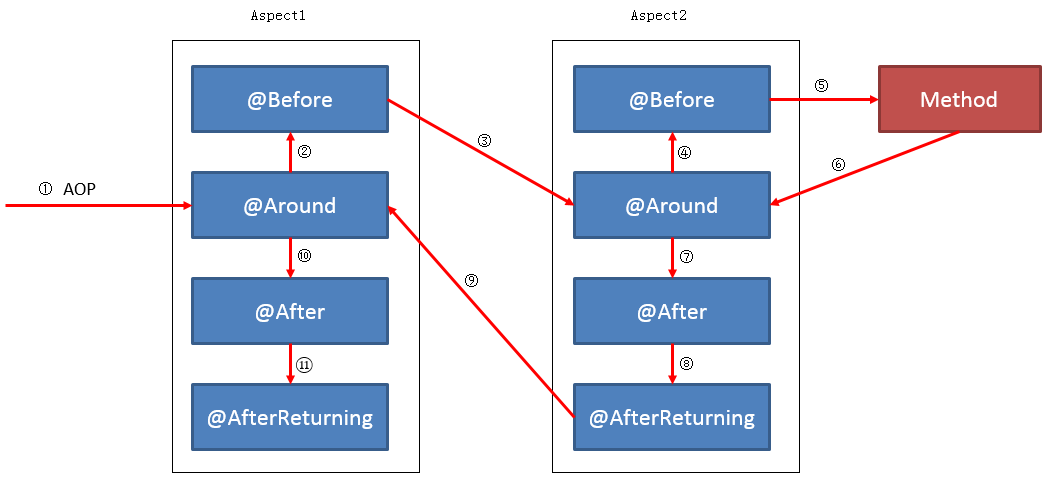Spring AOP @Before @Around @After 等 advice 的執行順序 侵立刪
用過spring框架進行開發的人,多多少少會使用過它的AOP功能,都知道有@Before、@Around和@After等advice。最近,為了實現專案中的輸出日誌和許可權控制這兩個需求,我也使用到了AOP功能。我使用到了@Before、@Around這兩個advice。但在,使用過程中,卻對它們的執行順序並不清楚。為了弄清楚在不同情況下,這些advice到底是以怎麼樣的一個順序進行執行的,我作了個測試,在此將其記錄下來,以供以後檢視。
前提 對於AOP相關類(aspect、pointcut等)的概念,本文不作說明。 對於如何讓spring框架掃描到AOP,本文也不作說明。 情況一: 一個方法只被一個Aspect類攔截 當一個方法只被一個Aspect攔截時,這個Aspect中的不同advice是按照怎樣的順序進行執行的呢?請看:
新增 PointCut類 該pointcut用來攔截test包下的所有類中的所有方法。
package test;
import org.aspectj.lang.annotation.Pointcut;
public class PointCuts { @Pointcut(value = "within(test.*)") public void aopDemo() {
} } 新增Aspect類 該類中的advice將會用到上面的pointcut,使用方法請看各個advice的value屬性。
package test;
import org.aspectj.lang.JoinPoint; import org.aspectj.lang.ProceedingJoinPoint; import org.aspectj.lang.annotation.*; import org.springframework.stereotype.Component;
@Component @Aspect public class Aspect1 {
@Before(value = "test.PointCuts.aopDemo()") public void before(JoinPoint joinPoint) { System.out.println("[Aspect1] before advise"); }
@Around(value = "test.PointCuts.aopDemo()") public void around(ProceedingJoinPoint pjp) throws Throwable{ System.out.println("[Aspect1] around advise 1"); pjp.proceed(); System.out.println("[Aspect1] around advise2"); }
@AfterReturning(value = "test.PointCuts.aopDemo()") public void afterReturning(JoinPoint joinPoint) { System.out.println("[Aspect1] afterReturning advise"); }
@AfterThrowing(value = "test.PointCuts.aopDemo()") public void afterThrowing(JoinPoint joinPoint) { System.out.println("[Aspect1] afterThrowing advise"); }
@After(value = "test.PointCuts.aopDemo()") public void after(JoinPoint joinPoint) { System.out.println("[Aspect1] after advise"); } } 新增測試用Controller 新增一個用於測試的controller,這個controller中只有一個方法,但是它會根據引數值的不同,會作出不同的處理:一種是正常返回一個物件,一種是丟擲異常(因為我們要測試@AfterThrowing這個advice)
package test;
import test.exception.TestException; import org.springframework.http.HttpStatus; import org.springframework.web.bind.annotation.*;
@RestController @RequestMapping(value = "/aop") public class AopTestController {
@ResponseStatus(HttpStatus.OK) @RequestMapping(value = "/test", method = RequestMethod.GET) public Result test(@RequestParam boolean throwException) { // case 1 if (throwException) { System.out.println("throw an exception"); throw new TestException("mock a server exception"); }
// case 2 System.out.println("test OK"); return new Result() {{ this.setId(111); this.setName("mock a Result"); }}; }
public static class Result { private int id; private String name;
public int getId() { return id; }
public void setId(int id) { this.id = id; }
public String getName() { return name; }
public void setName(String name) { this.name = name; } } } 測試 正常情況 在瀏覽器直接輸入以下的URL,回車:
http://192.168.142.8:7070/aoptest/v1/aop/test?throwException=false 1 我們會看到輸出的結果是:
[Aspect1] around advise 1 [Aspect1] before advise test OK [Aspect1] around advise2 [Aspect1] after advise [Aspect1] afterReturning advise 測試 異常情況 在瀏覽器中直接輸入以下的URL,回車:
http://192.168.142.8:7070/aoptest/v1/aop/test?throwException=true 1 我們會看到輸出的結果是:
[Aspect1] around advise 1 [Aspect1] before advise throw an exception [Aspect1] after advise [Aspect1] afterThrowing advise 結論 在一個方法只被一個aspect類攔截時,aspect類內部的 advice 將按照以下的順序進行執行:
正常情況:


pointcut類保持不變 新增一個新的aspect類 package test;
import org.aspectj.lang.JoinPoint; import org.aspectj.lang.ProceedingJoinPoint; import org.aspectj.lang.annotation.*; import org.springframework.stereotype.Component;
@Component @Aspect public class Aspect2 {
@Before(value = "test.PointCuts.aopDemo()") public void before(JoinPoint joinPoint) { System.out.println("[Aspect2] before advise"); }
@Around(value = "test.PointCuts.aopDemo()") public void around(ProceedingJoinPoint pjp) throws Throwable{ System.out.println("[Aspect2] around advise 1"); pjp.proceed(); System.out.println("[Aspect2] around advise2"); }
@AfterReturning(value = "test.PointCuts.aopDemo()") public void afterReturning(JoinPoint joinPoint) { System.out.println("[Aspect2] afterReturning advise"); }
@AfterThrowing(value = "test.PointCuts.aopDemo()") public void afterThrowing(JoinPoint joinPoint) { System.out.println("[Aspect2] afterThrowing advise"); }
@After(value = "test.PointCuts.aopDemo()") public void after(JoinPoint joinPoint) { System.out.println("[Aspect2] after advise"); } } 測試用Controller也不變 還是使用上面的那個Controller。但是現在 aspect1 和 aspect2 都會攔截該controller中的方法。
下面繼續進行測試!
測試 正常情況 在瀏覽器直接輸入以下的URL,回車:
http://192.168.142.8:7070/aoptest/v1/aop/test?throwException=false 1 我們會看到輸出的結果是:
[Aspect2] around advise 1 [Aspect2] before advise [Aspect1] around advise 1 [Aspect1] before advise test OK [Aspect1] around advise2 [Aspect1] after advise [Aspect1] afterReturning advise [Aspect2] around advise2 [Aspect2] after advise [Aspect2] afterReturning advise 但是這個時候,我不能下定論說 aspect2 肯定就比 aspect1 先執行。 不信?你把服務務器重新啟動一下,再試試,說不定你就會看到如下的執行結果:
[Aspect1] around advise 1 [Aspect1] before advise [Aspect2] around advise 1 [Aspect2] before advise test OK [Aspect2] around advise2 [Aspect2] after advise [Aspect2] afterReturning advise [Aspect1] around advise2 [Aspect1] after advise [Aspect1] afterReturning advise 也就是說,這種情況下, aspect1 和 aspect2 的執行順序是未知的。那怎麼解決呢?不急,下面會給出解決方案。
測試 異常情況 在瀏覽器中直接輸入以下的URL,回車:
http://192.168.142.8:7070/aoptest/v1/aop/test?throwException=true 1 我們會看到輸出的結果是:
[Aspect2] around advise 1 [Aspect2] before advise [Aspect1] around advise 1 [Aspect1] before advise throw an exception [Aspect1] after advise [Aspect1] afterThrowing advise [Aspect2] after advise [Aspect2] afterThrowing advise 同樣地,如果把伺服器重啟,然後再測試的話,就可能會看到如下的結果:
[Aspect1] around advise 1 [Aspect1] before advise [Aspect2] around advise 1 [Aspect2] before advise throw an exception [Aspect2] after advise [Aspect2] afterThrowing advise [Aspect1] after advise [Aspect1] afterThrowing advise 也就是說,同樣地,異常情況下, aspect1 和 aspect2 的執行順序也是未定的。
那麼在 情況二 下,如何指定每個 aspect 的執行順序呢? 方法有兩種:
實現org.springframework.core.Ordered介面,實現它的getOrder()方法 給aspect新增@Order註解,該註解全稱為:org.springframework.core.annotation.Order 不管採用上面的哪種方法,都是值越小的 aspect 越先執行。 比如,我們為 apsect1 和 aspect2 分別新增 @Order 註解,如下:
@Order(5) @Component @Aspect public class Aspect1 { // ... }
@Order(6) @Component @Aspect public class Aspect2 { // ... } 這樣修改之後,可保證不管在任何情況下, aspect1 中的 advice 總是比 aspect2 中的 advice 先執行。如下圖所示:

對於@Around這個advice,不管它有沒有返回值,但是必須要方法內部,呼叫一下 pjp.proceed();否則,Controller 中的介面將沒有機會被執行,從而也導致了 @Before這個advice不會被觸發。比如,我們假設正常情況下,執行順序為”aspect2 -> apsect1 -> controller”,如果,我們把 aspect1中的@Around中的 pjp.proceed();給刪掉,那麼,我們看到的輸出結果將是:
[Aspect2] around advise 1 [Aspect2] before advise [Aspect1] around advise 1 [Aspect1] around advise2 [Aspect1] after advise [Aspect1] afterReturning advise [Aspect2] around advise2 [Aspect2] after advise [Aspect2] afterReturning advise 從結果可以發現, Controller 中的 介面 未被執行,aspect1 中的 @Before advice 也未被執行。
參考資料 Spring 4.3.2.RELEASE 官方資料:http://docs.spring.io/spring/docs/current/spring-framework-reference/htmlsingle/ 其中,AOP的執行順序章節為:http://docs.spring.io/spring/docs/current/spring-framework-reference/htmlsingle/#aop-ataspectj-advice-ordering Advice ordering
What happens when multiple pieces of advice all want to run at the same join point? Spring AOP follows the same precedence rules as AspectJ to determine the order of advice execution. The highest precedence advice runs first "on the way in" (so given two pieces of before advice, the one with highest precedence runs first). "On the way out" from a join point, the highest precedence advice runs last (so given two pieces of after advice, the one with the highest precedence will run second).
When two pieces of advice defined in different aspects both need to run at the same join point, unless you specify otherwise the order of execution is undefined. You can control the order of execution by specifying precedence. This is done in the normal Spring way by either implementing the org.springframework.core.Ordered interface in the aspect class or annotating it with the Order annotation. Given two aspects, the aspect returning the lower value from Ordered.getValue() (or the annotation value) has the higher precedence.
When two pieces of advice defined in the same aspect both need to run at the same join point, the ordering is undefined (since there is no way to retrieve the declaration order via reflection for javac-compiled classes). Consider collapsing such advice methods into one advice method per join point in each aspect class, or refactor the pieces of advice into separate aspect classes - which can be ordered at the aspect level. !
